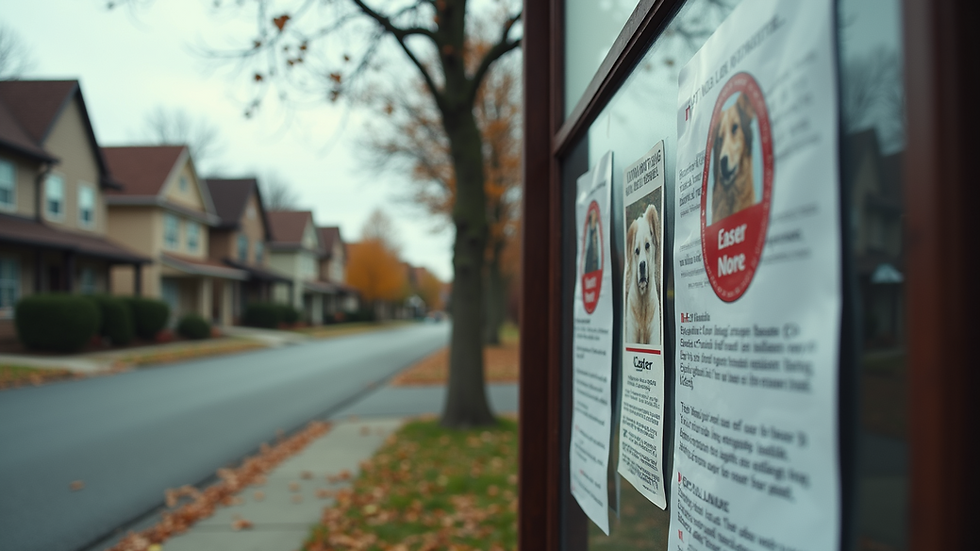Steps to Bring Lost Pets Back Home Safely
- allpawsreunited
- Sep 2
- 3 min read
Losing a pet can be a heart-wrenching experience. Pets are more than just animals; they are family members who bring joy and companionship. When a pet goes missing, the urgency to bring them back safely is overwhelming. Fortunately, there are practical steps you can take to increase the chances of a happy reunion. This guide will walk you through effective strategies to find and bring your lost pet back home safely.
Act Quickly to Reunite Lost Pets
Time is critical when a pet goes missing. The sooner you start searching, the better the chances of finding your pet unharmed. Begin by thoroughly checking your home and immediate surroundings. Pets often hide nearby when scared or disoriented.
Next, expand your search to the neighborhood. Walk or drive around, calling your pet’s name and listening for any response. Bring along their favorite treats or toys to attract them. It’s important to stay calm and patient during this process.
Create and distribute flyers with a clear photo of your pet, description, and your contact information. Post these flyers in high-traffic areas such as community centers, grocery stores, and veterinary clinics. Social media platforms and local lost-and-found pet groups are also powerful tools to spread the word quickly.

Use Technology and Community Resources to Reunite Lost Pets
Technology can be a game-changer in locating lost pets. Many apps and websites specialize in lost pet alerts. Register your pet as missing on these platforms to reach a wider audience. Websites like all paws reunited offer resources and community support to help reunite lost pets with their owners.
Microchipping your pet is one of the most effective preventive measures. If your pet is microchipped, notify the microchip company immediately so they can flag your pet as missing. This increases the chances that a shelter or vet will contact you if your pet is found.
Contact local animal shelters, rescue groups, and veterinary offices. Provide them with a detailed description and photo of your pet. Visit shelters in person regularly, as descriptions over the phone may not always be accurate.
Create a Safe and Familiar Environment for Your Pet’s Return
When your pet is found or returns home, it’s important to create a calm and welcoming environment. Pets may be scared or disoriented after being lost. Prepare a quiet space with their favorite bedding, toys, and food.
If your pet has been missing for several days, take them to a veterinarian for a health check. They may have injuries or illnesses that need attention. Be patient and gentle as your pet readjusts to being home.
Reinforce safety measures to prevent future escapes. Check fences, gates, and doors for any weak spots. Consider using a GPS tracker on your pet’s collar for added security.

Spread Awareness and Educate Your Community
Community involvement is crucial in preventing and responding to lost pets. Organize or participate in local pet safety workshops to educate others about responsible pet ownership. Topics can include microchipping, secure fencing, and proper identification tags.
Encourage neighbors to report sightings of lost pets and to keep an eye out for unfamiliar animals. Building a network of vigilant and caring community members increases the chances of quickly locating lost pets.
Use social media to share tips and success stories. Positive reinforcement motivates others to take action and helps build a supportive pet-loving community.
Keep Hope Alive and Stay Persistent
Finding a lost pet can take time, and it’s important to stay hopeful and persistent. Many pets are found weeks or even months after going missing. Continue updating flyers, checking shelters, and engaging with online communities.
Remember to take care of yourself during this stressful time. Reach out to friends, family, or support groups for emotional support. Your calm and determined approach will help your pet feel safe and loved when they return.
By following these steps and utilizing available resources, you can increase the chances of a joyful reunion with your lost pet. For additional help and community support, consider visiting all paws reunited.
Bringing a lost pet back home safely requires quick action, community involvement, and the use of modern tools. By staying organized and proactive, you can navigate this challenging situation with confidence and compassion. Your pet’s safe return is worth every effort.





Comments